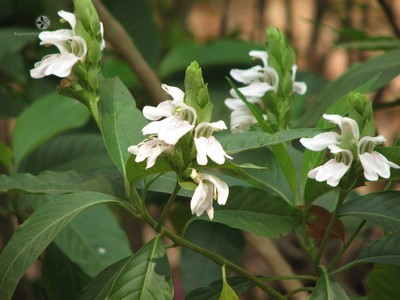
Common Name: Vasaka, Adulsa
English Name: Malabar Nut
Botanical Name: Adhatoda vasica Nees
Family: Acanthaceae
Description: This shrub grows on the plains of India and in the lower Himalayans, up to a range of 1000 meters above sea level. This plant is also cultivated in other tropical areas. It grows well in low moisture areas and dry soils. It is a large shrub grows crowded along waste land, roadsides etc. Leaves are simple, opposite, ovate-lanceolate, acute and shiny. Flowers are white in capsule shape.
Chemical Composition: Main chemical components are vasicine, 2'-hydroxy -4-glucosyloxychalcone, vasicol, adhatodine, vasicinone, vasicinol, arachidic, cerotic, behenic, lignoceric, linoleic and oleic acids. The pharmacological uses of Adhatoda is believed to be the result of its rich concentration of alkaloids. The prominent alkaloid found in Adhatoda leaves is the quinazoline alkaloid known as vasicine. In addition to vasicine, the leaves and roots of Adhatoda contain the alkaloids l-vasicinone, deoxyvasicine, maiontone, vasicinolone and vasicinol. Research indicates that these chemicals are responsible for Adhatoda’s bronchodilatory effect.
Properties: Adhatoda has been used in traditional medicine to treat respiratory disorders. Both vasicine and vasicinone the primary alkaloid constituents of Adhatoda are well established as therapeutical respiratory agents Extracts of Adhatoda’s leaves and roots are useful in treating bronchitis, and other lung and bronchiole disorders, as well as common coughs and colds. Adhatoda vasica has immense potential as an anti-ulcer agent. Adhatoda vasica was found to increase bile activity.
Used in the following MATXIN products: